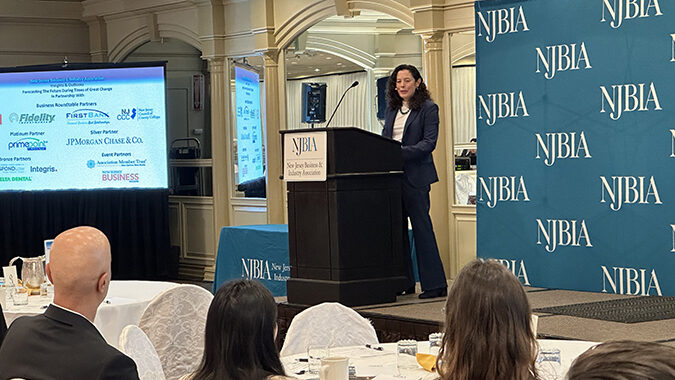Vast technological and demographic changes are disrupting the world of higher education right now, and New Jersey must rethink how it educates its workforce both now and in the future.
That was the message Maria Heidkamp, chief of Innovation and Partnerships at the New Jersey Council of County Colleges, delivered at NJBIA’s recent “Insights & Outlooks” forum in Edison, which brought together business, education and government leaders to discuss trends shaping the future of learning, workforce training and upskilling.
“The labor force participation rate remains low, which means there are people we could or should lure back to the workplace,” Heidkamp said. Although women who had to leave the workforce during the pandemic are mostly back now, “there are far too many prime age men, mostly without college degrees, who are on the sidelines.”
A high school education alone is not enough anymore in an evolving global digital knowledge economy that is being transformed by artificial intelligence, virtual reality and augmented reality, Heidkamp said.
“Technology – AI, VR, and AR robotics will continue to change how we live, work and learn,” she said.
Postsecondary learning is also rapidly evolving to meet the challenge and the “metaversity” has gone from theory to reality at places like Morehouse College which hosts classes in digitally simulated environments, allowing students to learn with remote people in nontraditional locations. In a metaversity, students can be transported using virtual reality to learn surgical techniques in a cadaver biolab, study evolution in the Galapagos Islands, explore Mars, and more.
“Early data has found that students prefer learning in a 3-D VR classroom and end up with better grades,” Heidkamp said. “These same technologies will change the workplace and many current workers, myself included, will need some upskilling to learn how to work side by side with AI and smart robots.”
Another disrupter in the world of higher education is the need for short-term credentials that provide students with more choices and a quicker way to obtain specific skills that make them attractive to employers, she said. However, assessing the quality of the thousands of postsecondary credentials available remains a significant challenge for educators and employers.
“There will still be a place for two- and four-year degrees, but this won’t be the only way students consume education,” she said.
Demographic workforce changes are another disrupter, Heidkamp said. “We know there are fewer high school students coming our way, and there are more older working and lifelong learners, which means we have to focus on designing workforce training and upskilling with adults in mind.”
“The bottom line is business as usual is not going to work,” Heidkamp said. “Given these disruptive forces, New Jersey needs to rethink how, when and where it educates and trains its current and future workforce – and community colleges are uniquely situated to help lead and partner in this task.”
The New Jersey Council of County Colleges and its Community College Consortium for Workforce and Economic Development have partnered with NJBIA on the New Jersey Pathways to Career Opportunities initiative that has brought together over 1,000 industry and educational partners to align education to build an innovative workforce, she said. The Pathways initiative, which serves as a model for other states, is focused on four key, in-demand industries: health services; manufacturing and supply chain management; technology and innovation; and infrastructure and energy.
Using the state’s infrastructure and energy employers as an example, Heidkamp pointed out how the educational institutions that are part of the Center of Workforce Innovation for Renewable Energy are working with these businesses to build educational pathways for future workers in the wind energy sector where there will be tremendous job growth in the years ahead.
“The wind energy pathway builds upon associate and bachelor’s degree programs under development currently by Rowan College of South Jersey and Rowan University. To connect to high school students, the team has developed project awareness experiences that utilize games and simulations related to electricity generated via wind turbines,” Heidkamp said. “For community colleges they developed an exploration in wind energy careers workshop.
“In terms of work-based learning, they’re developing wind turbine technician pre-apprenticeship and apprenticeship programs,” Heidkamp said, noting that programs will be awarded 15 college credits that stack to an academic certificate or an associate degree to help students get credit for their industry-valued credentials.
It has been challenging to get all the community colleges, four-year colleges, a myriad of employers, unions, and other stakeholders in the same boat “all rowing in the same direction,” Heidkamp said.
“With all these partners, as Chief Brody said in ‘Jaws,’ we’re going to need a bigger boat,” Heidkamp said. “But it’s clear this is the beginning of a beautiful friendship, and we welcome any employers who want to be part of the Pathways solution.”

